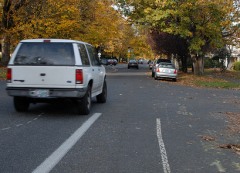
(Photo © J. Maus)
When bike lane striping disappears through an intersection, does the legal standing of a person operating a bicycle in that lane also vanish?
Last month, Multnomah County traffic court judge Michael Zusman ruled that it does and the decision has left many people confused and concerned. We checked in with Zusman, the woman who was hit (City of Portland employee Carmen Piekarski), and a bike law expert to get an update.
“In general, my authority as a judge is limited: I am bound to interpret the law the way it is written, not as I (or others) might wish it to be.”
— Michael Zusman, Mult. County Circuit Judge Pro Tem
Ms. Piekarski said her shoulder still doesn’t work quite right (saying “it still doesn’t move certain directions without pain and cracking”), but she has no plans for a civil lawsuit. Piekarski has talked with a lawyer about her case, but the conversation is focused on insurance law. About the decision to not bring a lawsuit against the driver of the Prius that hit her, Piekarski says, “I don’t want my energy wound up in this for years. I just want to get out of this what I’ve had to put into it.”
Piekarski has also written an email to her state representative in Salem, Ben Cannon (who happens to be a regular bike rider himself). “I sent him the link to your story and asked, ‘what can we do about this?'”
With a civil suit off the table, some have wondered whether a change is needed to the Oregon state law to clarify the situation.
“We disagree [with the judge] in several respects…If traffic lanes all ceased to exist in intersections, legal chaos would ensue and every intersection without lines painted for every lane would turn into a legal free-for-all.”
— Ray Thomas, lawyer and bike law expert
Bike law expert Ray Thomas thinks the law is fine the way it is. He’s written an article about the case he hopes will clarify the situation titled, Bike Lane Right of Way Continues Even Without Painted Line Through Intersection (40kb PDF here).
In the article, Thomas writes that he disagrees with Zusman’s decision and acknowledges the “great consternation” it has caused, but reminds us that, “…the decision does not create binding legal precedent.”
But even so, Thomas wants people to know that according to official legal and road design references in Oregon, a person on a bike does not lose the right of way in a bicycle lane when the striping drops through an intersection.
Here’s Thomas’ thinking:
“Bicycle lane” is defined in ORS 801.155 as ‘that part of the highway, adjacent to the roadway, designated by official signs or markings for use by persons riding bicycles…’
The court ruling fails to recognize that the legal existence of a bicycle lane does not end just because the paint on the road stops at an intersection…
Bicycle lane designation by markings or signs creates a legal status for bicyclists that does not require the presence of paint on the pavement in the intersection because lanes (even motor vehicle lanes) continue even when the paint stops. It is the markings or designations visible before and after the intersection that create the legal presence of the bicycle lane…
If traffic lanes all ceased to exist in intersections, legal chaos would ensue and every intersection without lines painted for every lane would turn into a legal free-for-all.”
Thomas also consulted the Oregon Department of Transportation’s Oregon Bicycle and Pedestrian Plan (which was updated in 2007):
“The rules for design and installation of bicycle lanes in the Oregon Bicycle and Pedestrian Plan suggest that the painted stripe should usually stop at the crosswalk and resume on the other side of the intersection. Interruption of the paint stripe does not interrupt the bicycle lane…”
Based on these findings, Thomas feels that no legislative fix is necessary “because the law is clear.”
Judge Michael Zusman disagrees. In an email response to our request for a phone interview, he wrote that his authority as a judge is limited and that he’s “bound to interpret the law the way it is written, not as I (or others) might wish it to be.” Going further, he wrote, “If the “spirit of the law” is at odds with the plain language of a statute, it is within the exclusive province of the Legislature to fix the problem.”
As for Piekarski, she’s just hoping she can recoup some of her expenses from the insurance company of the woman who turned into her. She’s also counting her blessings that the collision didn’t end up a lot worse. “Ultimately, I’m an extremely lucky person.”

